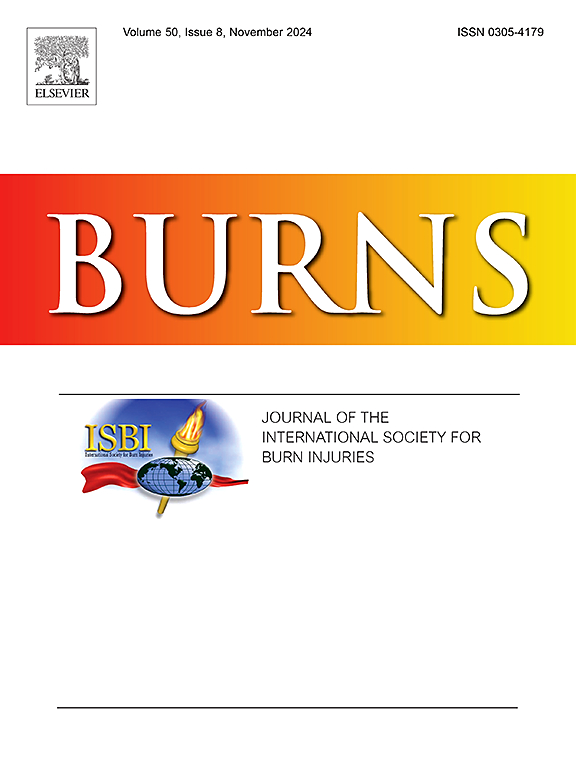Evaluating inter-and intra-rater reliability in the bronchoscopic grading of burn inhalation injury: The iBRONCH-BII study
IF 2.9
3区 医学
Q2 CRITICAL CARE MEDICINE
引用次数: 0
Abstract
Background
The evidence that the severity of burn inhalation injury (BII) impacts clinical outcomes is inconsistent. This may be due to misclassification arising from the subjectivity in bronchoscopically grading BII using systems such as the Abbreviated Injury Score (AIS). This study aimed to evaluate inter- and intra-rater reliability in the grading of BII using the AIS.
Methodology
In a cohort study, specialist burns clinicians (n = 17) and novices (n = 10) graded sixteen BII bronchoscopic images using the AIS during an online meeting. Inter-rater reliability was evaluated using the Kappa statistic (k), with values < 0.60 considered clinically inadequate. The grade rating process was repeated after seven days to evaluate intra-rater reliability. Evaluation of reliability in the grading of BII bronchoscopy reports was conducted as a sensitivity analysis.
Results
Amongst all raters, inter-rater reliability was low for grading images (k = 0.30, 95 % confidence interval (CI): 0.29–0.31). Intra-rater reliability was higher than inter-rater reliability, but was still low, with median image grade rate k = 0.45 (interquartile range [IQR]:0.24–0.53). Intensivists demonstrated the highest rater reliability.
Conclusion
Reliability in rating the grade of BII by bronchoscopic images was clinically inadequate. Strategies to improve the reliability of reporting the grade of BII are required.
评估支气管镜下烧伤吸入性损伤分级的内部和内部可靠性:iBRONCH-BII研究
背景:烧伤吸入性损伤(BII)严重程度影响临床结果的证据并不一致。这可能是由于使用简易损伤评分(AIS)等系统进行支气管镜下BII分级时的主观性导致的错误分类。本研究旨在评估使用AIS对BII进行评分时评分间和评分内的可靠性。在一项队列研究中,烧伤专科临床医生(n = 17)和新手(n = 10)在一次在线会议中使用AIS对16张BII支气管镜图像进行分级。使用Kappa统计量(k)评估评估间信度,值<; 0.60被认为临床不充分。7天后重复评分过程以评估评分者内部的可靠性。对BII支气管镜报告分级的可靠性进行敏感性分析。结果在所有评分者中,评分者之间的信度较低(k = 0.30,95 %置信区间(CI): 0.29-0.31)。评分内信度高于评分间信度,但仍较低,图像分级率中位数k = 0.45(四分位数间距[IQR]: 0.24-0.53)。强化医生表现出最高的可靠性。结论支气管镜图像对BII分级的可靠性在临床上存在不足。需要提高BII等级报告可靠性的策略。
本文章由计算机程序翻译,如有差异,请以英文原文为准。
求助全文
约1分钟内获得全文
求助全文
来源期刊

Burns
医学-皮肤病学
CiteScore
4.50
自引率
18.50%
发文量
304
审稿时长
72 days
期刊介绍:
Burns aims to foster the exchange of information among all engaged in preventing and treating the effects of burns. The journal focuses on clinical, scientific and social aspects of these injuries and covers the prevention of the injury, the epidemiology of such injuries and all aspects of treatment including development of new techniques and technologies and verification of existing ones. Regular features include clinical and scientific papers, state of the art reviews and descriptions of burn-care in practice.
Topics covered by Burns include: the effects of smoke on man and animals, their tissues and cells; the responses to and treatment of patients and animals with chemical injuries to the skin; the biological and clinical effects of cold injuries; surgical techniques which are, or may be relevant to the treatment of burned patients during the acute or reconstructive phase following injury; well controlled laboratory studies of the effectiveness of anti-microbial agents on infection and new materials on scarring and healing; inflammatory responses to injury, effectiveness of related agents and other compounds used to modify the physiological and cellular responses to the injury; experimental studies of burns and the outcome of burn wound healing; regenerative medicine concerning the skin.
 求助内容:
求助内容: 应助结果提醒方式:
应助结果提醒方式:


